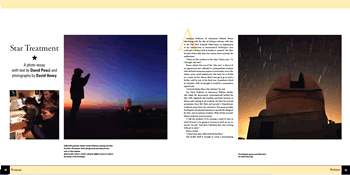Star Treatment
 ASSISTANT PROFESSOR OF ASTRONOMY EDWARD MORAN was toying with the idea of taking a webcam with him to the Kitt Peak National Observatory so sophomores in his Introduction to Astronomical Techniques class could get a closeup look at hands-on research. But then he had a better idea: leave the camera home and take the sophomores.
ASSISTANT PROFESSOR OF ASTRONOMY EDWARD MORAN was toying with the idea of taking a webcam with him to the Kitt Peak National Observatory so sophomores in his Introduction to Astronomical Techniques class could get a closeup look at hands-on research. But then he had a better idea: leave the camera home and take the sophomores.
“There are five students in the class,” Moran says. “So I thought, why not?”
Moran admits that one of the “why nots” is that such an opportunity isn’t afforded to undergraduate students with declared astronomy majors at universities across the nation, never mind sophomores who have yet to decide on a major. In fact, Moran didn’t even get to go to such a facility until he was in his third year of graduate school at Columbia. Still, he thought it would be a tremendous opportunity.
“Certainly better than a live webcast,” he said.
Van Vleck Professor of Astronomy William Herbst, who heads the department, enthusiastically backed the idea. Still, logistical and funding questions loomed, so Moran said nothing to his students. But then he received permission from Kitt Peak and secured a Rosenbaum/Andersen grant from the university. The grant provides funding for educational experiences specifically designed for first- and second-year students. With all this in hand, Moran made his announcement.
“I told the students I’d be missing a week of class in April because I was going to Arizona to work on my research,” he said. “And then I told them they were coming with me to assist.”
Moran smiles.
“I think their jaws collectively hit the floor.”
The facility itself is enough to create a jaw-dropping effect. Perched at the top of a mountain in the Sonoran desert about 50 miles southwest of Tucson, Arizona, Kitt Peak is one of the world’s elite observatories. It is home to the largest collection of telescopes anywhere (25 optical and two radio), which draw researchers from colleges, universities, and other institutions from around the world. Wesleyan buys a month’s worth of observation time on one of the telescopes each year.
Along with its impressive array of telescopes, Kitt Peak also affords observers an increasingly rare work environment: the truly dark sky.
“Most of these students come from urban or suburban areas so they’ve never seen a night sky without some degree of ambient light,” Moran says. “The number of stars that can be seen in a dark sky just standing outside after sunset using the naked eye can be quite breathtaking.”
During the three nights of observations the students assisted Moran with his ongoing research: studying a galaxy with a super-massive black hole at its center that exhibits uniquely rapid changes in brightness. It’s 13-million light years away—relatively close in astronomical terms. He hopes to discover the cause of the variation in brightness.
“The students were actively involved with my research and basically worked and interacted like other researchers at Kitt Peak,” Moran said.
This included the use of the telescope to make observations all night long. They also handled some of the other essential activities such as working with the bank of computers, acquiring calibration data, and attending to the monitoring and refilling of liquid nitrogen needed to keep the detector cold. The students also interacted with other researchers at the facility, not just at the telescopes and computers, but also informally in the dining hall and around the campus of the facility.
“It gave me a better idea for what the minute-by-minute experience of observing is like,” says Matt Johnson ’07. “Observing is a big part of astronomy and it was amazing to get the opportunity to do it hands-on at a ‘real’ place like Kitt Peak.”
For Seth Cohen ’07, it was a defining experience.
“I knew I was interested in astronomy, but I wasn’t sure if actually having it as a career was right for me,” says Cohen. “After the trip, however, I realized that everything I learned how to do at Kitt Peak only made me more fascinated with the subject, thus affirming my interest in eventually having astronomy as a career.”
Sounds like it beats a webcam hands down.

